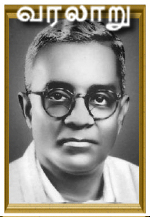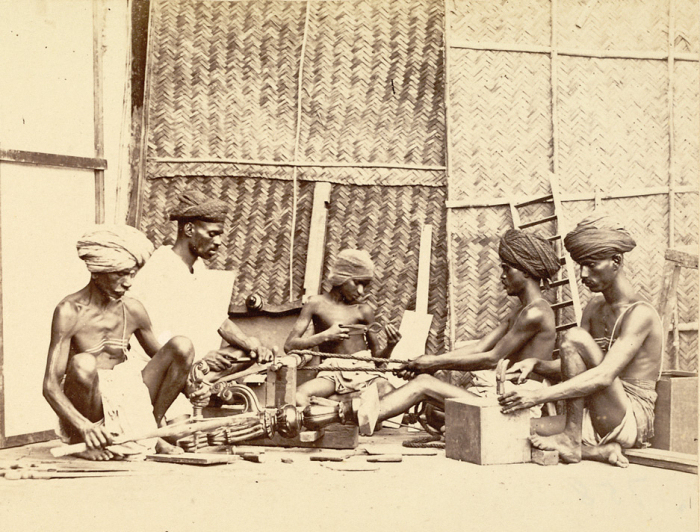 |
 |
 |
http://www.varalaaru.com A Monthly Web Magazine for South Asian History [187 Issues] [1839 Articles] |
 |
 |
 |
http://www.varalaaru.com A Monthly Web Magazine for South Asian History [187 Issues] [1839 Articles] |
|
Issue No. 119

இதழ் 119 [ மே 2015 ] டாக்டர் மா.இராசமாணிக்கனார் வரலாற்றாய்வு மையச் சிறப்பிதழ் 
இந்த இதழில்.. In this Issue.. 
|
A Study on Nagaram in Thiruchirappalli District (Between C. E. 500 and 1300)
Dr.R.Kalaikkovan, Dr.M.Nalini and Dr.R.Akila The settlement which was mainly mercantile in nature was called nagaram and its name was generally distinguished by the suffix puram. They were administered by the land holding merchant community of that village mentioned in the inscriptions as nagarattar. This corporate body resembles the urar and sabha in having collective responsibility in administration. As the other two assemblies, nagarattar also were involved in multi various activities such as land dealings, tax-collection and remission, acceptance of endowments agreeing to carry out the stipulated services in the local temples and the up keep of temple affairs. They also probably had committees known as variyam, though there is not much detail available in the records of the study area but for the mention of a certain nagara variyan in a few inscriptions. They had their own accountant by name nagara kanakku who is also mentioned in a few records as madhyastan. The deeds and agreements are signed by the members of the nagaram only in the later records and not in the early ones. In this they resembled the other two assemblies namely urar and nattar wherein individual signatories are rarely noted in the early periods and differed from the sabha wherein they appear from the beginning.  Cirrambar An analysis of the available inscriptions of the study period for the tenurial status of the villages reveals a very small percentage of mercantile settlements in the study area, Thiruchirappalli district. The earliest of them being Cirrambar, a mercantile village included under Uraiyur kurram probably covered the modern Thiruchirappalli town, mentioned in two of the early Pandya inscriptions available at the upper rock cut cave temple of Thiruchirappalli. Both the records belong to Varaguna I and register endowments made by the Pandya king. The first gift was made through Velan of Andanadu towards gold diadems to the presiding deity of the hill temple. The endowment was entrusted with the nagarattar of Cirrambar. The second gift of 125 kalanju of gold was also entrusted with the same nagarattar as deposit towards burning of lamps at the hill temple out of the interest accrued from it. It is understood from a later inscription of Kulottunga I copied during field study from the Ujjivanathar temple of Uyyakkondan Thirumalai that Cirrambar was also known as Uttamacholapuram during that period. Several records of later part of the study period from the Jambukesvaram temple at Thiruvanaikkoyil and Sriranganatha temple at Srirangam mention Cirrambar and assert to its continued existence as a mercantile settlement. It is fascinating to note that most of the accountants of both the temples were from this village. Manigramam Manigramam of Uriayur and Manigramam of Rajakesaripuram in Malanadu are noted in two early inscriptions copied from Srinivasanallur in Musiri taluk and Thiruvellarai in Thiruchirappalli taluk as settlements of a particular group of nagarattar. The name Rajakesaripuram with the suffix puram itself stands as an explicit evidence to attest that it was a mercantile village. It is interesting to note that manigramam, a group of merchants, had several such settlements at various parts of Tamilnadu such as Kodumbalur, Kaveripumpattinam, Ilankopattinam and Adittanur. References are also available from Kerala about this sea fearing merchant guild. It may be recalled here that an inscription of early period (9th century) copied from Takuapa of Thailand mentions this group of merchant guild who probably formed a colony more or less permanently in that area. It is unfortunate that none of these inscriptions provide any useful information on any of their administrative activities but for mentioning some individuals of this group as donors or signatories or as persons who received honours. Uraiyur Nagarattar An inscription of Kulottunga I from Ujjivanathar temple at Uyyakkondan Thirumalai records the meeting of Uraiyur nagarattar at Uttamachola Vinnagar Alvar temple to carry out a sale deed. A portion of land of the nagarattar was sold to an individual by name Kasyaban Narayanan of Rajasraya chaturvedimangalam for 2½ kasu which he had gifted to the deity of the temple towards flower offerings. The land was made tax-free by the nagarattar after accepting 150 kalam of paddy as irai kaval deposit and the document is mentioned as ‘irai kaval pramanam’. It was prepared by Chirudai Kalal Aravanaiyan, the accountant of the nagaram. The signatories include the authorities of the temple, Rangan Karkudaiyan, the nagara variyan and other members of the nagaram. It may be presumed that the Uraiyur nagarattar mentioned in this record may be a division or the descendants of manigramattar of the earlier records. Pachil vaniga gramam Pachil vaniga gramam and Vaniya nagaram of both the banks of the river Kaveri (irandu karai nadu) are the other two mercantile settlements noted in the study area. Among the two, Pachil vaniga gramam was included under Pachchil kurram, a subdivision of Rajaraja valanadu of the northern bank of the river Kaveri. A merchant of this place Kamapiriyam Ambalavan alias Valavakon of Chiruvelur with the title ‘etti’, sold Vadavur owned by him to the temple authorities of Painnili for a price of anradu narkasu 12,000 during the 27th regnal year of Rajaraja III. Details about the nagaram are not available in the record. (To be continued) |

சிறப்பிதழ்கள் Special Issues 

புகைப்படத் தொகுப்பு Photo Gallery 
|
| (C) 2004, varalaaru.com. All articles are copyrighted to respective authors. Unauthorized reproduction of any article, image or audio/video contents published here, without the prior approval of the authors or varalaaru.com are strictly prohibited. | ||